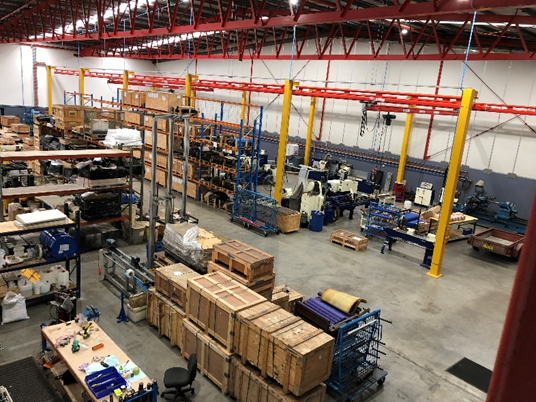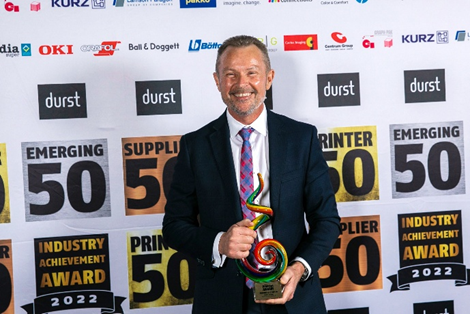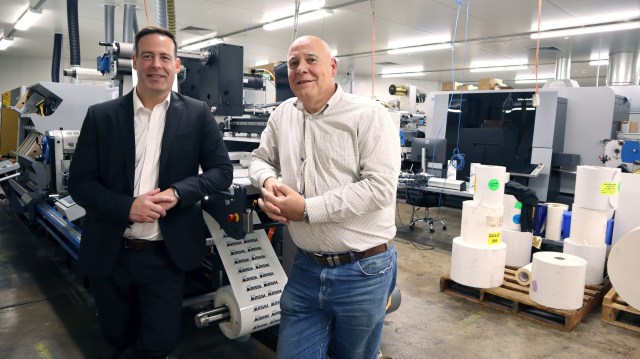
The Böttcher Group today stands on the foundation of 300 years of history – a long-standing past that gives the business confidence into the future.
The Böttcher Group celebrates 300 years of operation this year, with its anniversary marking the company’s enduring success across multiple countries and industries.
Böttcher is now known as a leading supplier in elastomer-coated roller technology, especially in the coating of rotationally symmetrical bodies (rollers, sleeves) in industrial applications.
Additionally, Böttcher serves as a development partner to more than 400 machine manufacturers globally – around 70 per cent of all printing presses built worldwide are initially equipped with roller coatings from Böttcher.
The company also supplies customers from a wide range of industries with consumables such as washing agents, printing blankets, coating plates, dampening solution additives, and other printing aids. Böttcher holds a similarly strong position in the metal, plastics, and wood industries.
The foundations of today’s global Böttcher Group were laid by two companies: the tannery founded by Jacobus Loosen in Cologne in 1725 and Felix Böttcher’s Leipzig-based company to produce gelatine rollers, which was established around 150 years later.
The two medium-sized companies merged in 1910, and elastomer roller coatings were used for the first time in 1952.
Today, Böttcher’s technology is used in all continents across 123 countries, 38 of which have their own employees and 27 production sites in 19 countries. Every day, 2,000 employees serve more than 50,000 customers around the globe.
“For 300 years – from 1725 to 2025 – Böttcher has written a success story in eventful times that is now recognised worldwide across many industrial sectors. We owe this to the commitment, work, and skill of all Böttcherians over the past 300 years,” Böttcher Group managing director Franz-Georg Heggemann said.
“During this time, a family business with a first-class reputation for its products and services has emerged that is independent of third parties.”

The Böttcher story
The origins of Böttcher date back to 11 July 1725 when Jacobus Loosen founded a business manufacturing high-quality leather in Rothgerberbach, located on what was then the outskirts of Cologne. This business continued for 100 years until his grandson Johann Georg Loosen took over.
He switched production to the manufacture of glue for bookbinders and woodworkers, which could be obtained from the waste from the tannery. In 1890, after returning from travels to England, Wilhelm Loosen convinced his father to switch to the production of gelatine roller mass.
The production process was very similar to the manufacture of glue and the industry experienced rapid growth. The roller compound was sourced from printers, who were still moulding their own rollers at the time.
Independently, Felix Böttcher started producing printing roller compound in Leipzig as early as 1878 and his successor, Ernst Herrmann, began casting his own rollers for printers in 1883.
Loosen had been offering this service since 1895. However, competition in the German Empire increased and so the two companies merged in 1910 and from then on, produced rollers together.
Foreign business was strengthened over the next few years and further sites were established. Herrmann’s financial and sales support for the first web offset press, built by VOMAG (now Manroland Web Systems), was revolutionary in 1912.
In the early 1930s, a new phase began with the entry into rubber roller production. After the Second World War, Böttcher managed to rebuild, but the company in Leipzig was expropriated and nationalised. From the 1950s onwards, Böttcher experienced a strong upswing driven by innovative products and a well-developed supply network and became a close partner of printing press manufacturers. Despite the oil price crisis, internationalisation continued, with Böttcher also producing in England and Italy from 1973.
Over the decades, Böttcher expanded its global presence by opening new production sites and acquiring competitors. For example, rollers were manufactured in the US from 1987, in Thailand from 2002, and in China from 2005. This expansion was based on the new mixing plant built in 1990, which significantly increased the company’s production capacity for roller compounds.
Shortly after, the production of handrails began, rubber compounds were offered to external customers, and roller customers beyond the printing industry were established. The in-house development of production machines for the series production of OEM and exchange rollers gave Böttcher a decisive advantage over others. This was put into operation in Cologne in 2000. Böttcher grew to its current size and defied the financial crisis in 2008 and the coronavirus pandemic in 2020.
Over the course of three centuries, Böttcher has developed from a small, German craft business into a globally active company, transforming from a traditional animal hide tanner to a leading supplier of rollers.
Böttcher’s entry into Australia
In 1998, Böttcher Group embarked on an expansion plan into Australia and New Zealand and approached Mitch Mulligan to lead the helm. Mulligan, who is currently managing director of Böttcher Australia, recalls the early days were exceptionally busy, with him having to juggle multiple roles within the business.
“Böttcher Group knew of my background, and I’d been involved in the rollers space previously. The chance for a younger Mitch was great and I took on the opportunity to launch the Australian business,” he said.
“We started the business in Australia from my kitchen table 27 years ago. At that time, I was very hands-on, and I was involved in almost every role and function within the business – I was customer facing during the day and then would head back to the warehouse to pack and dispatch orders.
“We transformed the landscape of rollers in Australia. We took them from a position where there was a high rate of replacement and failure, to restoring the longevity of rollers in machines.”
Forging ahead, Mulligan first set up a team of sales professionals in Queensland and Victoria, then grew the team across the entire East Coast.
“Year-on-year we grew the business. We got it to the point where we arrived as the market leader in the graphic arts market,” he said.
“In 2018, we acquired our competitor and merged the two businesses together, establishing manufacturing for Böttcher in Australia for the first time.”
1998 also marked the year Mulligan signed a distributor in New Zealand – Nova Inks & Chemicals. That company retains distributorship of Böttcher in New Zealand, but now under Huber Group.



The Böttcher we know today
Today, there are 20 staff at Böttcher Australia, with its local headquarters located in Smithfield, NSW.
“In the early days, we moved premises every five years – we started off in Rydalmere, then moved to a larger location in Castle Hill, and then again to another larger location up the road in Castle Hill. When we merged the two businesses together, we moved into a new site at Smithfield, which we operate out of today,” Mulligan said.
Whether for the production and processing of metals, plastics and cellulose, or textiles and wood, rollers from Böttcher has become an integral part of many industrial processes.
Böttcher rollers apply, dose, distribute, immerse, deflect, pull off, press, peel, emboss or squeeze. In addition, the durable and energy-saving roller coatings support the development of new, environmentally friendly packaging printing materials.
Its diverse range of solutions has enabled the business to reach an array of verticals, including industrial packaging and industrial technical rollers.
“Launching into new verticals has enabled us with a continuous stream of new business. The growth in flexible packaging, gravure, and flexo printing has allowed us to have a greater focus in the industrial packaging vertical. As for the industrial technical roller vertical, it expands our presence in a variety of industries because they have a need for rubber covered cylinders doing different applications and work,” Mulligan said.
“Where we were heavily a graphic arts business about six years ago, we’re now 50 per cent graphic arts and 50 per cent industrial packaging and industrial rollers business. That’s really changed our business structure. The graphic arts segment is consolidating, and we can’t be standing idle and need to grow our business, which is what we’ve done.
“We aim to continue growing into new verticals and expanding our vertical markets by investing into our own capabilities and adding new customers.
“We’re a long-term business, so our relationships with key clients go back many years. We want to further build on that success with new customers.”
Another important building block for the company’s success is the strong focus on in-house research and development expertise globally.
The 70 researchers at Böttcher Group develop and test materials that meet the high standards of measurable benefits for its customers. As the production of roller materials is a supreme discipline within the rubber industry, the Cologne based company operates its own mixing plant in Gelsdorf, Germany. This guarantees the high and consistent quality of its materials – no matter where in the world they are processed.
“We develop about 300 different compounds a year and bring on board about half a dozen into commercial reality. We always look forward to offering improved products to achieve greater efficiencies, lower cost of ownerships, and better productivity – that’s what drives us,” Mulligan said.


A strong future
At Böttcher, economic performance, social responsibility, and a considerate approach to nature are inextricably linked. Sustainability is also an integral part of its corporate policy.
By adopting a holistic approach, Böttcher takes responsibility for future generations from the earliest stages of product development, through procurement, production, and sales. The goal is for Böttcher products to actively contribute to greater sustainability throughout their lifecycle.
According to Mulligan, Böttcher has a multi-pronged sustainability model that operates like a circular economy.
“Everything we do is generally aimed at reducing the consumption of our product – they’re now safer, have less VOC content in them, and have greater efficiencies. So, in a lot of our products, we try to get a ‘triple tick’ – a lower cost of ownership, lower consumption, and higher performance,” he said.
“We also refurbish and recover used rollers, saving them from going into skip bins. In addition, we look at our individual operations and come up with ways to reduce our carbon footprint – whether that be putting solar on the roof or changing the way the whole plant operates.”
Mulligan sees a strong future for Böttcher, fuelled by digital drivers such as AI.
“Even as a manufacturing company, that sort of digital driver can be of great assistance. You’ve just got to work out what it is and where it fits, but I can see it being able to assist in everything from production right through to administration and customer experiences,” Mulligan said.
“We are so lucky to have a company that has such stability, is constantly evolving itself and its product lineup, and invests not only in product development but the people in it as well. Böttcher Australia sees organic growth and is cash positive, and having the backing of Böttcher Group gives us constant strength to keep evolving and growing.”
Böttcher’s milestones
1725 – Jacobus Loosen starts the tanning of animal hides for leather in Cologne, Germany
1825 – Glue production begins for the shoe, paper, and wood industries
1878 – Felix Böttcher starts with gelatine compound production in Leipzig, Germany
1893 – First gelatine rollers are made by Böttcher themselves
1910 – Loosen and Felix Böttcher merge to fight increasing competition
1912 – Böttcher starts production of “Böttcherin” roller washes
1933 – First rollers with rubber coverings are produced
1973 – First international production sites open in UK and Italy
1982 – Printing blankets become part of the product portfolio
1987 – First production site in America starts up in Belcamp, US
1987 – Foundation of joint venture company KBRT with Kinyosha
1990 – New rubber mixing facility opened in Gelsdorf
1995 – Rubber mixing for external customers starts
1995 – Beginning of Handrail production for escalators
1996 – Czech Roller production opens
2000 – Automated serial production of OEM and exchange rollers start
2002 – First production site in Asia established in Bangkok, Thailand
2005 – Roller manufacturing plant opens in Suzhou, China
2009 – Operations start in South America, Argentina and Brazil with own chemicals
2013 – Roller production in Brazil opens
2016 – Böttcher acquires three roller manufacturing sites in Hungary, Romania, and Serbia
2017 – Böttcher produces rubber rollers in India
2025 – Böttcher employs 2,000 employees in 38 countries and runs 27 production sites in 19 countries
Comment below to have your say on this story.
If you have a news story or tip-off, get in touch at editorial@sprinter.com.au.
Sign up to the Sprinter newsletter






